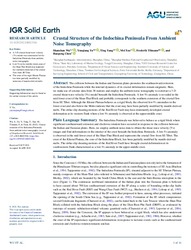Crustal Structure of the Indochina Peninsula From Ambient Noise Tomography
DOI: https://doi.org/10.1029/2021JB023384
Persistent URL: http://resolver.sub.uni-goettingen.de/purl?gldocs-11858/10399
Persistent URL: http://resolver.sub.uni-goettingen.de/purl?gldocs-11858/10399
Supplement: https://doi.org/10.5281/zenodo.5235658
Wu, Shanshan; Yu, Youqiang; Yang, Ting; Xue, Mei; Tilmann, Frederik; Chen, Haopeng, 2022: Crustal Structure of the Indochina Peninsula From Ambient Noise Tomography. In: Journal of Geophysical Research: Solid Earth, Band 127, 5, DOI: 10.1029/2021JB023384.
 |
Dokument öffnen: |
The collision between the Indian and Eurasian plates promotes the southeastward extrusion of the Indochina Peninsula while the internal dynamics of its crustal deformation remain enigmatic. Here, we make use of seismic data from 38 stations and employ the ambient noise tomography to construct a 3‐D crustal shear‐wave velocity (Vs) model beneath the Indochina Peninsula. A low‐Vs anomaly is revealed in the mid‐lower crust of the Shan‐Thai Block and probably corresponds to the southern extension of the crustal flow from SE Tibet. Although the Khorat Plateau behaves as a rigid block, the observed low‐Vs anomalies in the lower crust and also below the Moho indicate that the crust may have been partially modified by mantle‐derived melts. The strike‐slip shearing motions of the Red River Fault may have dominantly developed crustal deformation at its western flank where a low‐Vs anomaly is observed at the upper‐middle crust. Plain Language Summary:
The Indochina Peninsula was believed to behave as a rigid block where significant southeastward extrusion and clockwise rotation have occurred in response to the collision between the Indian and Eurasian plates. Here, we employ ambient noise data to obtain the shear‐wave velocity (Vs) images and find deformations in the interior of the crust beneath the Indochina Peninsula. A low‐Vs anomaly is observed in the mid‐lower crust of the Shan‐Thai Block and represents the crustal flow from SE Tibet. The crust of the Khorat Plateau, the core of the Indochina Block, has been partially modified by mantle‐derived melts. The strike‐slip shearing motions of the Red River Fault have brought crustal deformation at its southwestern flank characterized as a low‐Vs anomaly in the upper‐middle crust. Key Points:
A 3‐D crustal shear‐wave velocity (Vs) model was constructed for the Indochina Peninsula from ambient noise tomography.
Low‐Vs in the middle‐lower crust of the Shan‐Thai Block may represent the southern extension of the crustal flow from SE Tibet.
The crust of the rigid Khorat Plateau has been partially modified by intrusion of mantle‐derived melts.
Statistik:
ZugriffsstatistikSammlung:
This is an open access article under the terms of the Creative Commons Attribution License, which permits use, distribution and reproduction in any medium, provided the original work is properly cited.

